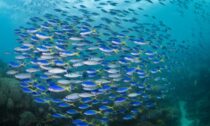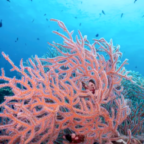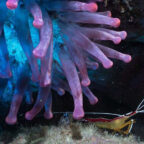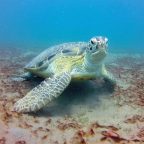
New research shows that fully protected areas had 30% more fish species and 2.5 times more fish biomass compared with open areas. It is becoming increasingly clear that humankind must do more to protect our ocean. It generates about half of the planet’s oxygen, regulates our climate, and is home to 80% of all life on Earth. Yet, ocean health is critically threatened by human activities that are driving the collapse of fisheries, the loss of biodiversity, and the acidification of seawater.
There is a growing recognition among political leaders, Indigenous groups, communities, and scientists that governments and other regulatory bodies need to protect and conserve at least 30% of Earth’s coastal and marine areas by 2030 to secure and maintain a healthy ocean. Marine protected areas (MPAs) are the primary tool for conserving marine ecosystems. Yet, as two recent studies show, the design and management of these areas greatly affect their efficacy in delivering the desired benefits for nature and people.
In Australia, partial marine protections yielded no ecological benefits
The majority of global MPAs are only partially protected, which means that although they restrict some extractive activities, they allow several others—often including damaging ones such as commercial fishing. This makes those MPAs significantly less effective at preserving biodiversity than areas with stronger restrictions, according to a recent study of MPAs along the southern coast of Australia.
The study, which published in January in the journal Conservation Biology, compared partially and fully protected MPAs along 7,000 kilometers of Australia’s Southern Great Reef. Examining biodiversity and abundance data, researchers found no more fish, invertebrates, or algae in partially protected areas than in unprotected waters. Fully protected areas, in contrast, had 30% more fish species and 2.5 times more fish biomass compared with areas with no restrictions.
Fully protected MPAs increase fish stocks in overfished reefs
Similarly, another study, published this month in Marine Policy, examined the long-term impacts of no-take MPAs in Kenya and showed that high protections increased fish populations by 42% and were more effective at sustaining fish stocks compared with areas where the only restrictions were on fishing methods.
Researchers examined recorded fish catches over 24 years in two Kenyan counties, representing the longest-ever study of continuous detailed fish catch record for coral reefs. One county used a fully protected MPA covering 30% of its fishing grounds, while the other implemented restrictions only on gear, including prohibiting small-mesh nets. The study showed that per-person daily catches increased 25 times faster in waters around the no-take MPA than in the areas that had only gear restrictions. Although researchers observed some short-term positive ecological benefits in gear-restricted areas, the polices did not maximize fishery productivity over the long term.
By safeguarding 30% of its fishing grounds in a fully protected MPA, the county of Mombasa was able to not only compensate for lost fishing area but also witnessed a substantial increase in fish populations. As the study explained, no-take MPAs “therefore help people highly dependent on fish for income and nutritional security that is lost when catches are unsustainable.”
Strong protections are critical for long-term ocean health
These two studies build on a growing body of research that shows the importance of strong protections for achieving conservation benefits. A study published in 2018 that examined MPAs around the world found that highly protected waters showed higher biomass and abundance of commercial fish species than unprotected areas, while weakly regulated areas showed minimal ecological benefits. Similarly, researchers examining the Mediterranean Sea found that only 28% of protected areas had regulations sufficient to reduce human impacts on biodiversity. The science shows that fully protected, well-managed MPAs remain the best tool to conserve biodiversity and ecosystems, improve long-term food security, and protect ocean-based livelihoods.
The United Nations Convention on Biological Diversity is currently negotiating a new 10-year strategy for nature and people, including draft text to protect and conserve at least 30% of the global ocean by 2030. The plan would establish a “post-2020 biodiversity framework” for conserving and restoring nature that integrates many objectives included in the U.N.’s sustainable development goals and the Paris climate agreement, defining new milestones and targets for the preservation of nature through 2030 and beyond. As global leaders work toward these objectives, it’s vital that they consider the quality of protections—not just the quantity—and pursue those proven to achieve conservation outcomes that help secure the long-term health of our planet.
Jérôme Petit is a senior manager and Johnny Briggs is a senior officer with the Pew Bertarelli Ocean Legacy Project.















Social Profiles